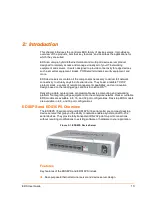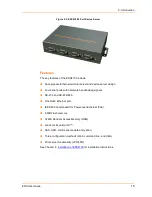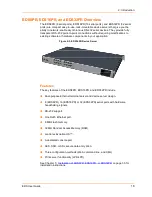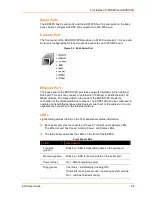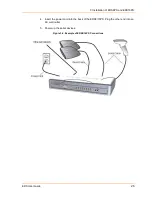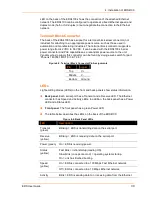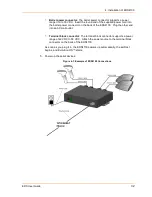
2: Introduction
EDS User Guide
19
device. SCPR is a Windows application that creates a secure communications path
over a network between the computer and serial-based devices that are traditionally
controlled via a COM port. With SCPR installed at each computer, computers that
were formerly “hard-wired” by serial cabling for security purposes or to accommodate
applications that only understood serial data can instead communicate over an
Ethernet network or the Internet.
Terminal Server/Device Management
Remote offices can have routers, PBXs, servers and other networking equipment that
require remote management from the corporate facility. The EDS easily attaches to
the serial ports on a server, Private Branch Exchange (PBX), or other networking
equipment to deliver central, remote monitoring and management capability.
With the menu system on the EDS, connections to the console ports of the attached
devices as well as Ethernet hosts, such as Unix servers or another EDS, can easily
be picked from a user-defined menu. This allows console ports across multiple
devices to be accessed from one EDS.
Troubleshooting Capabilities
The EDS offers a comprehensive diagnostic toolset that lets you troubleshoot
problems quickly and easily. Available from the Web Manager, CLI, and XML
interfaces, the diagnostic tools let you
View critical hardware, memory, MIB-II, buffer pool, and IP socket information.
Perform ping and trace route operations.
Conduct forward or backup DNS lookup operations.
View all processes currently running on the EDS, including CPU utilization and
total stack space available.
Configuration Methods
After installation, the EDS requires configuration. For the unit to operate correctly, it
must have a unique IP address on the network. There are three basic methods for
logging into the EDS and assigning IP addresses and other configurable settings:
DeviceInstaller: Configure the IP address and related settings and view current
settings on the EDS using a Graphical User Interface (GUI) on a PC attached to a
network. (See 6: Using DeviceInstaller on page 38.)
Web Manager: Through a web browser, configure the EDS settings using the
Lantronix Web Manager. (See 7: Configuration Using Web Manager on page 41.)
Command Mode: There are two methods for accessing Command Mode (CLI):
making a Telnet connection or connecting a terminal (or a PC running a terminal
emulation program) to the unit serial port. (See the EDS Command Reference Guide
for instructions and available commands.)
XML: The EDS supports XML-based configuration and setup records that make
device configuration transparent to users and administrators. XML is easily editable
with a standard text or XML editor. (See the EDS Command Reference Guide for
instructions and commands.)
Содержание EDS32PR
Страница 37: ...5 Installation of EDS8PR EDS16PR or EDS32PR EDS User Guide 37 Figure 5 4 Example of EDS16PR Connections...
Страница 42: ...7 Configuration Using Web Manager EDS User Guide 42 Figure 7 1 The EDS Web Manager Status Home Page...
Страница 116: ...12 Maintenance and Diagnostics Settings EDS User Guide 116 Figure 12 16 Diagnostics Buffer Pools...









